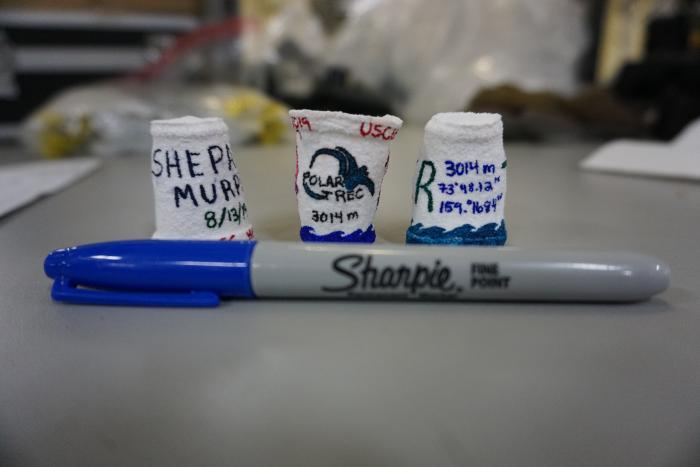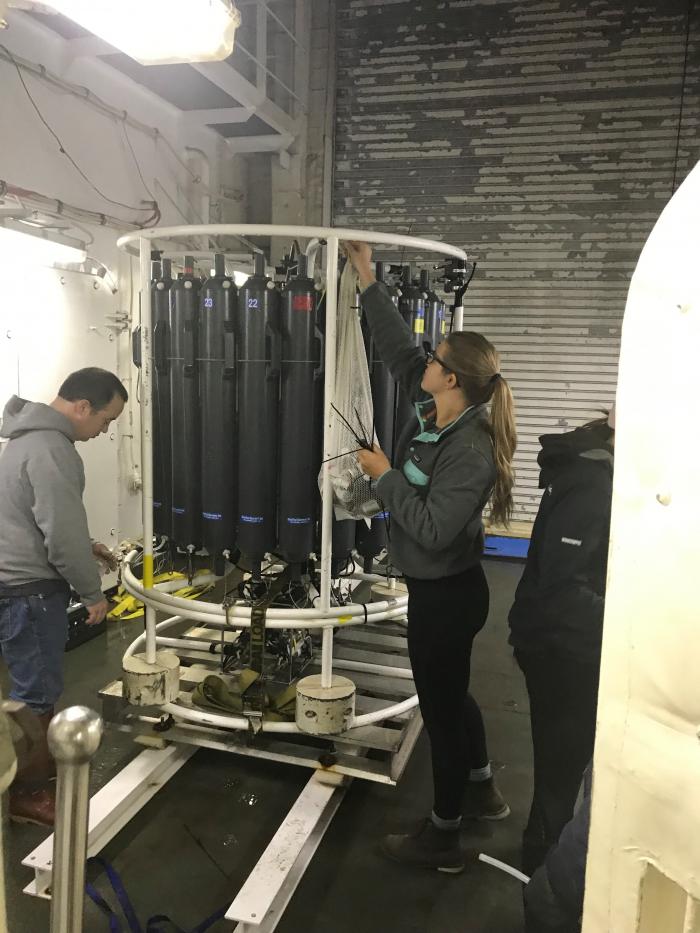In the early hours this morning, the Healy deployed its deep CTD cast at 73.4812 north latitude and 159.1684 west longitude. It was a frenzy of activity as everyone was looking to get some samples from such a deep sampling site. The CTD was deployed at around midnight and descended 3,014 meters to the bottom of the Chukchi Sea before returning to the deck of the Healy around 2:45am. Going to that depth takes a long time! Going down was relatively quick, but coming back up was slow going. Part of this was that the 24 Niskin bottles on the CTD were collecting water at 24 different depths during the ascent.
 The CTD reading during the deep cast with depth (m) on the y-axis.
The CTD reading during the deep cast with depth (m) on the y-axis.
During the day, researchers and Coast Guard decorated styrofoam cups to be attached to the CTD and sent down during the deep cast. The pressure of the water column at 3,014 meters squishes the cups down to a fraction of their original size. At sea level, the pressure is 0 atm(atmospheres) and 0 psi(pounds per square inch). At 3,014 meters below sea level, the pressure is at 298.81 atm or 4,288.25 psi. After decorating a cup with Sharpie, paper towels were put in them to help them keep their shape. All of the styrofoam was put into a mesh laundry bag and attached to the CTD to make the long journey down to the bottom of the ocean.
 The styrofoam cups before the deep cast.
The styrofoam cups before the deep cast.
 The styrofoam cups after the deep cast. So tiny!
The styrofoam cups after the deep cast. So tiny!
 Piper Bartlett-Browne and Caitlin Meadows take paper towels out of the crushed cups in the lab.
Piper Bartlett-Browne and Caitlin Meadows take paper towels out of the crushed cups in the lab.
Once the CTD was back on ship, everyone needing water samples lined up. The door to the CTD loading dock remained closed for sampling to keep the dissolved oxygen and other gases preserved in the samples. If warmer temperatures from the inside of the ship made its way to the Niskin bottles with the water, it could alter the dissolved gases by releasing them from the samples. For example, at higher temperatures, oxygen does not stay dissolved in water as readily. The Healy will only do one deep cast during its expedition and I was happy to be a part of it today!
 Eric Wisegraver (NOAA) and Caitlin Meadows, a PhD student, begin to collect water samples from the deep cast CTD.
Eric Wisegraver (NOAA) and Caitlin Meadows, a PhD student, begin to collect water samples from the deep cast CTD.
A Question From the Crow's Nest
What is the deepest point in the ocean and what is the pressure there?
Answer from previous post: The two most harmful toxins caused by harmful algal blooms are demonic acid (DA) and saxitoxin (STX).


Comments
Add new comment